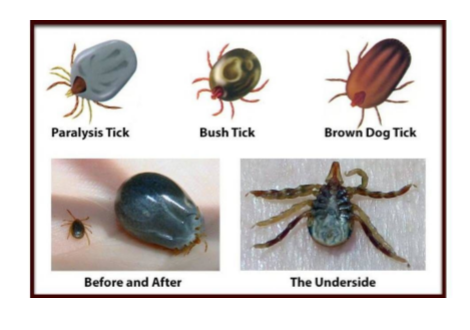Springtime is here! And whilst for many of us that means dusting off the bathing suit and heading to the beach, it also unfortunately means that paralysis tick season is in full swing. Here at Mcdowall Vets, we have already seen several cases of tick paralysis in the past few weeks.
Paralysis Ticks are native to Australia (mainly the east coast) and tend to travel around on marsupial hosts such as possums. These marsupials over time have built up immunity to the paralysing neurotoxin of these ticks. The ticks then drop off their hosts and are picked up by our pets in our yards or on their regular walks.
 What does a paralysis tick look like?
What does a paralysis tick look like?
Paralysis ticks can be identified by their grey body and legs close to the head. Their legs are the feature which best distinguishes them from other ticks that occur in the same regions. Paralysis ticks have one pair of brown legs closest to their head, then two pairs of white legs and then one pair of brown legs closest to the body.
Why are paralysis ticks so dangerous?
After attaching, the tick feeds on the host’s blood, injecting small amounts of saliva into the dog or cat in the process. The tick’s saliva contains a toxin that causes the connection between the nerves and muscles throughout the body to become disrupted. This causes weakness and ultimately paralysis.
This is not just limited to the muscles involved in standing and walking, but also to internal muscles such as those involved in breathing and swallowing, potentially causing serious compromise to breathing and can lead to pneumonia.
Ticks can survive in most conditions but are commonly picked up in bush land or around waterways. While tick paralysis is more common throughout the warmer, wetter months, they can occur year round.
What are the signs of tick paralysis?
The symptoms of tick paralysis include;
● Change in their voice
● Laboured breathing
● Gagging, Retching or Vomiting
● Coughing
● Trouble standing or walking, wobbly on their back legs
If your pet shows any of these symptoms, or if you find a tick on your pet, please call your vet immediately. Even if a tick is removed, the toxins could still be affecting your pet, so it is always best to get them to a vet as soon as possible (and take the removed tick with you!) Once at the vet, a tick search will be performed to find and remove all ticks. If your pet has very long or thick fur, a shave may be necessary to confirm that all ticks have been found. We will then give your pet an anti-tick serum to counteract the neurotoxins that the tick has secreted. Your pet will be monitored after the administration of the anti-serum to ensure no reactions occur. We will also check the function of the bladder to ensure that it is still operating correctly. In severe cases we will also use oxygen and intravenous fluids to help your pet. Depending on the severity of the case we may need to keep your pet overnight here or they may be required to go to an emergency vet for constant monitoring.
Tick paralysis is a very unpredictable disease with severe effects on the heart and respiratory muscles, and unfortunately not all animals survive, even with treatment.
Can I prevent tick paralysis?
Like anything, tick paralysis is easier to prevent than to treat. There are a few things you can do to reduce the likelihood of tick paralysis in your pet.
Try to avoid bushy and grassy areas where ticks tend to thrive. Carry out a daily tick search on your pets. Systematically work your way through your pets coat with your hands, feeling for unusual lumps, bumps or sores. Always check any folds in the neck and underneath their collar. Popular spots for ticks include, between the toes, in the ears, on the face, in the groin and underarm area and around the anus. Check your pets especially thoroughly if you have been walking out in the bush or if you have taken them camping for a few days. If you find one, don’t stop searching, if there is one, there could definitely be others.

You will also need to use a tick prevention product. At McDowall Vets we highly recommend Nexgard Flea and Tick prevention for dogs. It is a chewable tablet given monthly. For cats, we recommend Bravecto Spot-On which will prevent both fleas and ticks for 3 months. If you have any concerns about your pets and wish to speak to someone please feel free to call us on 07 33536999.
